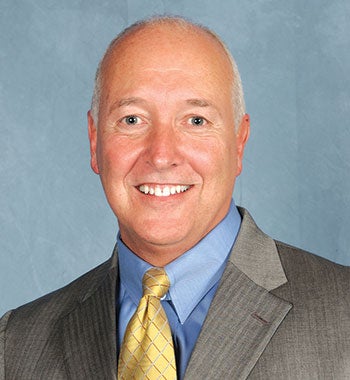Leading the charge to deliver innovation
 |
| Photo courtesy of The Innovation Institute Joe Randolph, president and CEO of the for-profit Innovation Institute. |
Joe Randolph, president and CEO of the for-profit Innovation Institute, La Palma, Calif., talks about the formation of the organization and how it’s diving headlong into helping health system professionals bring transformational products to market.
How did the Innovation Institute get started?
About four years ago, while I was chief operating officer of St. Joseph Health System, a $6 billion system in West Texas and California, we were preparing for the Affordable Care Act and the impact that it would have. In talking with my peers across the country, everybody was looking at how they were going to take 15 to 20 percent out of their cost structure.
But, in meeting with our CEO at the time, I explained that I didn’t think that incremental cost reduction would get us there. We needed to think differently about how we operate and to look at innovation and transformational change as a vehicle to help us achieve our goals. She was very supportive and we held a large summit of leadership from across the system to focus on innovation.
The summit generated a lot of excitement and we didn’t want to lose that momentum. Our CEO asked me to create a model that we could use to focus on innovation. In researching health care innovation centers, we found that there were some great groups but, for the most part, they focused only on their own organizations. I wanted this to be a collaborative to bring people together, including industry partners, to find solutions to the problems we all face.
When did you get the Institute launched?
We launched three years ago. We are authorized to have seven member owners as investors. St. Joseph was the first owner and launched the Institute with a $25 million investment, and we have the ability to draw another $20 million at any time. The intent was to recruit other systems so that this would be a stand-alone organization apart from St. Joseph’s, and so that it wouldn’t roll up under its financials.
Today, we have five systems that are owners: St. Joseph Health, Bon Secours, Franciscan Missionaries of Our Lady in Baton Rouge, Avera Health of Sioux Falls, S.D., and Children’s Hospital of Orange County (CHOC), and we’re seeking two more investors.
Each system, with the exception of CHOC, invested at least $10 million.
We wanted to include a space for children’s hospitals, but there really isn’t a system of children’s hospitals, so we dropped the threshold for pediatrics to $5 million. Each of the seven organizations will have a seat on the members’ committee and have a voice at the table.
What is the primary focus of the Innovation Institute?
We look at how to help employees and clinicians convert their ideas into products. We evaluate their ideas for commercial potential, protect the ideas and then take the products to market.
There are four ways people can partner with us. The first is traditional disclosure where someone brings an idea to us and we work with the inventor, evaluate the product idea and take it all the way to market.
Second, we can do facilitated innovation where we bring people to our innovation lab in Newport Beach, Calif.
The third way is to put an inventor’s idea out to a single or multiple health systems or to the general public through social media and ideation to solve problems, and we can offer rewards for those solutions.
We have people with PhDs and MBAs as well as physicians and other clinicians on our team who initially assess ideas. We also have an exclusive arrangement with Cleveland Clinic so that if we need deeper review, we have the ability to use their research arm and peer physician groups to weigh in on any tweaks needed to the design or idea.
The final way people can partner with us is through our industry partners like Boston Scientific, Dell, Deloitte and others we’re looking to bring on board.
What types of projects are in development?
We have about 300 ideas that have come to us through disclosure. Of those, about 35 percent are IT-related, about 45 percent are medical devices and the balance includes myriad other things.
The Randolph File |
| CV President and CEO of the Innovation Institute, a for-profit limited liability company structured to respond with agility to the long- and short-term needs of the health care field • More than 30 years of experience in health care leadership, most recently serving as the executive vice president and chief operating officer for St. Joseph Health System, one of the largest multistate Catholic health care systems in the United States with more than $5 billion in revenue The Institute at a glance The Institute comprises three distinct elements: Vision for the Institute “When I look back on this, I hope we can say that not only did we come up with some great devices that improve care delivery, but we also brought people together to focus on changes that had a big impact on care delivery.” |
For example, a surgeon at Hoag Hospital (Newport Beach) came up with a device that allows you to park and change needles to protect doctors from needlesticks and sharps injuries when they are in a patient room or in the operating room. It’s low-cost and something that’s been needed for years. He worked on it for a number of years and we were able to help him with the design and patents, and it will go to market.
Another example is an ankle therapy device. The physical therapist who came up with this was an Olympic-hopeful soccer player when he was younger and he suffered an ankle injury and never got the right kind of therapy and was unable to achieve his dream. Because of that he got into physical therapy and developed this device and there is nothing else out there like it. We’ve had it vetted by several different organizations and it basically isolates the different muscles and tendons within the ankle and strengthens them in a way that other devices don’t.
How does the Institute’s incubator accelerator lab work?
When we bring a health system on, we put intake staff at its location and our staff work with the people at their location; if they have ideas, our team will help them with disclosures and answer any questions they have.
Those teams are regionally located and they’ll determine whether we need to involve Cleveland Clinic or whether we can do the assessment on our own. Those ideas then are submitted to the evaluation team.
We review proposals to see what else is out there and whether there are patents that can protect the idea. We also have design groups that can help to develop prototypes, and then we’ll work with inventors to find exits.
Most of our exits are through licensing agreements — we receive a royalty and the inventor gets a significant benefit for his or her idea. It varies by system, but the inventor typically receives 40 percent of net proceeds, the Innovation Institute gets 40 percent and 20 percent goes to the inventor’s health care system. The health systems retain the intellectual property.
What’s unique or different about this development model?
Many programs have a product incubator, but it’s a cost center for the most part until you can get to cash flow. In our model, cash flows immediately because of our enterprise development group. In essence, this is a portfolio of companies that provide services to hospitals and health systems.
We have 10 portfolio companies generating about $150 million in revenue and about $12 million to $15 million earnings before interest, depreciation, taxes and amortization. We have that for the sole purpose of being the economic engine that allows us to be profitable from the get-go and we reinvest those dollars into innovation.




